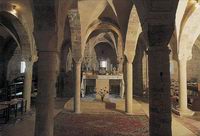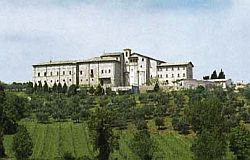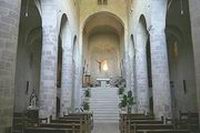Todi's country
Giano dell'Umbria
Giano
dell'Umbria was ruled by Spoleto from the mid-twelfth to the early
nineteenth century. Now it is the administrative centre for an area which
includes Montecchio and Castagnola; The castle, though not very large has
a complex structure which derives from the unification of two smaller
fortresses. The fortifications defend the urban centre on the top of the
hill, which include the town hall and the parish church of S. Michele
(thirteenth century). The medieval city-walls are well-preserved and
traces of the Roman walls can still be found.
The importance of the town is evident in the number of churches, first and
foremost S. Francesco, which stands just outside the city walls. The
single nave typifies the sort of building used by the 'poor mendicants'
who followed the rule of St. Francis of Assisi . The saintís story is
retold in a cycle of frescoes in the Crucifix Chapel which have been
attributed to Giovanni di Corraduccio (early fifteenth century). The
church of S. Maria is clearly medieval in origin, though it was remodelled
in the sixteenth and eighteenth centuries. The church of S. Biagio was
also built in the seventeenth century.



Giano dell'Umbria
Giano
dell'Umbria was ruled by Spoleto from the mid-twelfth to the early
nineteenth century. Now it is the administrative centre for an area which
includes Montecchio and Castagnola; The castle, though not very large has
a complex structure which derives from the unification of two smaller
fortresses. The fortifications defend the urban centre on the top of the
hill, which include the town hall and the parish church of S. Michele
(thirteenth century). The medieval city-walls are well-preserved and
traces of the Roman walls can still be found.
The importance of the town is evident in the number of churches, first and
foremost S. Francesco, which stands just outside the city walls. The
single nave typifies the sort of building used by the 'poor mendicants'
who followed the rule of St. Francis of Assisi . The saintís story is
retold in a cycle of frescoes in the Crucifix Chapel which have been
attributed to Giovanni di Corraduccio (early fifteenth century). The
church of S. Maria is clearly medieval in origin, though it was remodelled
in the sixteenth and eighteenth centuries. The church of S. Biagio was
also built in the seventeenth century.